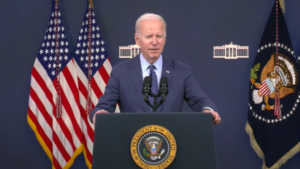President Biden said Thursday “nothing right now suggests” the three unidentified high-altitude objects the U.S. military shot down recently were surveillance capabilities, and may have likely been balloons for weather or scientific research purposes.
Biden noted the new government-wide effort to address how the U.S.’ deals with objects intruding into U.S. airspace will include “further measures to improve our capacity to detect unmanned objects.”

“We don’t yet know exactly what these three objects were, but nothing right now suggests they were related to China’s spy balloon program or that they were surveillance vehicles from any other country. The intelligence community’s current assessment is that these three objects were most likely balloons tied to private companies, recreation or research institutions studying weather or conducting other scientific research,” Biden said.
Biden’s remarks follow a spate of recent U.S. airspace intrusions where Raytheon Technologies [RTX]-built AIM-9X Sidewinder missiles fired from fighter jets were used to take down a Chinese surveillance balloon shot down off the coast of South Carolina on Feb. 4 and three other unidentified objects brought down off the coast of Alaska, in the Yukon territory of Canada and over Lake Huron last Friday, Saturday and Sunday respectively.
“[The military] acted in accordance with established parameters for determining how to deal with unidentified aerial objects in U.S. airspace. At their recommendation, I gave the order to take down these three objects due to hazards to civilian commercial air traffic and because we could not rule out the surveillance risk of sensitive facilities,” Biden said of the three most recent objects shot down.
Biden noted the administration has no evidence there’s been a “sudden increase in the number of objects in the sky,” echoing similar comments from officials recently that radar enhancements may explain the uptick in detections.
“We’re now just seeing more of them partially because of the steps we’ve taken to increase our radars and narrow our radars. And we have to keep adapting our approach to dealing with these challenges,” Biden said.
Air Force Gen. Glen VanHerck, head of North American Aerospace Defense Command and U.S. Northern Command, during a briefing on Sunday detailed how radar systems have been adjusted in light of the recent Chinese surveillance balloon intrusion, adding there’s also “heightened alert to look for this information” in the wake of that incident (Defense Daily, Feb. 13).
“Radars essentially filter out information based on speed. So you can set various gates. We call them velocity gates that allow us to filter out low-speed clutter. So if you have radars on all the time that we’re looking at anything from zero speed up to, say, 100, you would see a lot more information,” VanHerck said at the time. “We have adjusted some of those gates to give us better fidelity on seeing smaller objects. You can also filter out by altitude. And so, with some adjustments, we’ve been able to get a better categorization of radar tracks now. And that’s why I think you’re seeing these overall.”
John Kirby, spokesman for the White House’s National Security Council, noted on Monday that Biden has also directed the NSC to lead an interagency team “to study the broader policy implications for detection, analysis and disposition of unidentified aerial objects that pose either safety or security risks.”
Biden further details this effort on Thursday, and said it’s intended to “to make sure we’re positioned to deal safely and effectively with the objects in our airspace.”
“First, we’ll establish a better inventory of unmanned airborne objects above the United States’ airspace, and make sure that inventory is accessible and up to date. Second, we’ll implement further measures to improve our capacity to detect unmanned objects in our airspace. Third, we’ll update the rules and regulations for launching and maintaining unmanned objects in the skies above the United States of America. And fourth, my secretary of state will lead an effort to help establish common global norms in this largely unregulated space,” Biden said. “These steps will lead to safer and more secure skies for our air travelers, our military, our scientists and for people on the ground as well.”
The president said Thursday he has also tasked his national security team to come up with “sharper rules for how we will deal with these unidentified objects” moving forward.
“Going forward, these parameters will guide what actions we’ll take while responding to unmanned and unidentified aerial objects. We’re going to keep adapting them as challenges evolve, if it evolves,” Biden said. “They’ll remain classified so we won’t give our road map to our enemies to try to evade our defenses.”